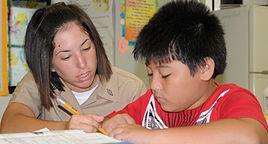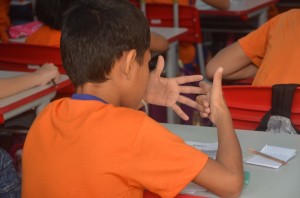You can see this explained in our YouTube video here.
The first step in setting up a Rocket Math tutoring program is to make a folder for your student. Your Rocket Math subscription gives you access to our filing cabinet on the web. Open the Forms and Information drawer, look under Forms for Every Student and you’ll see the three forms you need. Print out the Rocket Chart and staple it on the front of a manila folder. Print out the Goal Sheet and staple it inside of the folder on the left. Print out the Individual Student Graph and staple it inside the folder on the right. Voila! You now have a student folder!
Next you must decide what operation you intend to teach to your student. Generally, begin with addition in first and second grade, and subtraction after addition is mastered. Starting in third grade multiplication has priority even if addition and subtraction are not mastered. Division comes after multiplication has been mastered.
Depending upon how well you know your math facts, it might be a good idea to make an answer key booklet. If you have two children working with each other, it is essential! You find a Practice Answers A-Z booklet under Answer Keys within each operation. Make the answer keys by printing out the PRACTICE ANSWERS A-Z booklet on a distinctive color of paper and stapling it into a packet.
Next, print out the writing speed test (found in the Forms and Information drawer under “Forms for Every student.”) Then on the first day, give this one-minute writing speed test. You are going to take the information of how many boxes completed from the writing speed test and transfer it to the goal sheet. On the goal sheet highlight the row with the student’s writing speed test results. That row gives you your student’s individualized goals for the 1-minute daily test.
Each day follow the same routine. Set up practice by getting out the student folder, which should have the right practice sheet for the day. Next, congratulate your student if they passed their previous set and let them color in the Rocket Chart for the level they passed. Now, you are ready to begin practicing. Have the student practice with you for two or three minutes followed by taking the one-minute timing. After the test, have the student fill in the date of this try on their Rocket Chart. Then evaluate to see if the student passed. If they had no errors and they met their individualized goal for the 1-minute timing (from the goal sheet) they passed. Then print the next lettered set from the website. If they didn’t pass, print the same sheet to practice again tomorrow.
Daily practice is what makes Rocket Math work. The daily practice is verbal practice, with the student reading the problems around the outside of the Rocket Math worksheet and then saying answers aloud from memory as they go for two to three minutes. By saying the whole fact and the answer aloud each time, the student strengthens their memory of the whole verbal chain. Eventually, they can’t help but remember it—just like a popular advertising slogan. The daily oral practice is what makes Rocket Math work, not the tests! The daily practice is corrected practice, and it is essential that the tutor either knows the answers or has the answer key packet on colored paper, and the packet is turned to the matching page. While the student is practicing, all hesitations or errors are immediately corrected by the tutor. Once a student has read the problem aloud they should have already thought of the answer, so no hesitation is allowed.
If the student hesitates or makes an error, the tutor follows a specific three-step correction or teaching procedure. (1) The tutor interrupts to state the problem and the correct answer, (2) the tutor has the student repeat the problem and the correct answer three times, (3) then the student backs up three problems on the worksheet to give it another try.
Four days a week the student and tutor follow the daily practice routine and do the daily one minute timing. Once a week the student should do the 2-minute timing. This monitors progress and the student should graph their weekly results on the individual student graph inside their folder. If this is trending upward it is proof that the student is learning.
Here are some interventions, for students who are stuck. Remember: these students don’t need anything different, they just need more practice! (1) Make sure the student is not stopping during the test to erase, or look at the clock, or count on fingers, etc. (2) Do another 2-3 minute practice session daily (or two!). This will help kids get “over the hump” if they are stuck! (3) Just make sure to have at least a 30-minute break between practice sessions. (4) Try having students orally practice the tests also! (Because the test facts are different than the practice facts.)
You can expect students to be able to pass each set within 2 to 5 days—if you’re doing everything right. It’s important that students start at the beginning of an operation and are practicing correctly by saying the whole problem and the answer every time. Tutors must be correcting hesitations as well as errors and individualized goals must be based on the Writing Speed Test. If students are taking longer than two to five days, make sure they get extra practice sessions daily. For more suggestions see our website.











